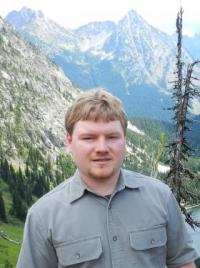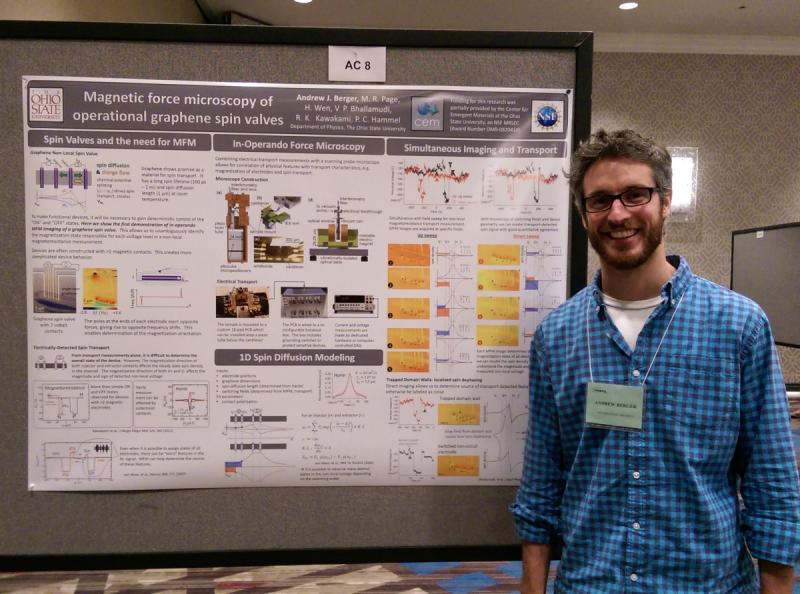Congratulations to Brendan McCullian for wining Best Poster Award at the 64th Annual Conference on Magnetism and Magnetic Materials (MMM) held at Las Vegas.
11 November 2019
Nicolas Scozzaro wins 2016 Student Project Grant from Tech Hub
Nic and Hiran Wijesinghe were awarded a 2016 Student Project Grant from Tech Hub for their app, "Physics is Beautiful." The award is a $2,000 grant to continue developing their project: an interactive website/app of physics lessons presented in a game-like environment. Congratulations for your innovative and successful idea, Nic!
Brendan McCullian wins 2014-2015 Hazel Brown Outstanding Teaching Assistant Award
26 April 2016
Congratuations to Brendan for winning the Hazel Brown Outstanding Teaching Assistant Award for the 2014-15 academic year!
Nicole Guo awarded 2016 Undergraduate Summer Research Scholarship from Department of Physics
11 April 2016
Congratulations to Nicole for her selection as a recipient of the department's 2016 Undergraduate Summer Research Scholarship!
Joe Schulze Wins at Denman Undergraduate Research Forum; Receives Mayers Summer Research Scholarship
6 April 2016
Congratulations to Joe for his Award at the Denman Forum last week! There were 670 presenters showcasing their research and competing for awards. Joe received the OSU Mayers Summer Research Scholarship,$3,500 in to continue his research this summer. Congrats on the recognition for your hard work, Joe!
Nic Scozzaro and Michael Page Awarded Dr. Clifford Heer Graduate Student Scholarship
9 March 2016
Nic Scozzaro and Michael Page are to be congratulated on their selection as winners in the Annual Graduate Students Poster Competition! Winners of the compeition are awarded the Dr. Clifford Heer Graduate Student Scholarship Award. The award in the Department of Physics was established September 21, 2007, with gifts in memory of Professor Emeritus Clifford Heer (B.S.Phys., 1942; Ph.D., 1949) from his wife, Esther Heer (B.S., 1949) and other family members for the purposes of recognizing scholarship in the field of Physics.
Joe Schulze Awarded 2015 Undergraduate Summer Research Scholarship from Physics Department
7 April 2015
Congratulations to Joe for his selection into the 2015 Undergraduate Summer Research Program! Scholars receive $3,500 in compensation for research work performed under the supervision of a supporting OSU Physics faculty member. Good work and well deserved, Joe!
Richelle Awarded the Ray Travel Award to attend the 2015 BPS Conference
3 Decemeber 2014
Richelle was recently awarded an Edward J. Ray Travel Award to attend the 2015 Biophysical Society (BPS) 59th Annual Meeting, which will be held in Baltimore, Maryland in February. The Ray Travel Award is administered by the OSU Council of Graduate Students. Unlike other programs that grant travel funds, the Ray Award gives substantial weight to the applicant's service to his/her department, the university, and the surrounding community. Ray Award judges also take into account the academic standing of the applicant, the applicant's professional goals, the nature of the conference being attended, and the applicant's ability to convey the focus of their research to a general audience.
Congrats, Richelle!
Michael Page and Shane White Win Graduate Teaching Assistant Award!
1 Decemeber 2014
Congratuations to Michael Page and Shane White for both winning the Hazel Brown Outstanding Teaching Assistant Award for the 2012-13 academic year! They will both earn a $550 scholarship.
Welcome back Michael Page and Shane White!
Hammel Group grad students return from 3-month internship at HGST San Jose Research Center
23 September 2014
Hammel Group grad students Michael Page and Shane White recently returned from a 3-month internship at the San Jose Research Center. Michael worked with Dr. Jeff Childress and his group on low temperature magneto-transport measurements of highly spinpolarized Heusler alloys and of sensor test structures based on those materials. Shane White worked with Dr. Paul van der Heijden on the modeling and characterization of next generation recording heads. Shane's project entailed taking detailed measurements of the magnetic field radiated 10nm away from a Spin-Torque Oscillator using a microfabricated nanocoil.
Hammel Group poster ties for first place at PASPS VII Conference
Andy presented "Magnetic force microscopy of operational graphene spin valves," this past weekend at the Physics and Applications of Spin Phenomena in Solids conference. The poster tied for first place in the student poster competition. The work was done in collaboration with Mike Page, Hua Wen, Vidya Bhallamudi, Roland Kawakami and Chris Hammel.
Could diamonds be a computer's best friend?
23 March 2014
Pam Frost Gorder
For the first time, physicists have demonstrated that information can flow through a diamond wire. In the experiment, electrons did not flow through diamond as they do in traditional electronics; rather, they stayed in place and passed along a magnetic effect called "spin" to each other down the wire—like a row of sports spectators doing "the wave."
Spin could one day be used to transmit data in computer circuits—and this new experiment, done at The Ohio State University, revealed that diamond transmits spin better than most metals in which researchers have previously observed the effect.
Researchers worldwide are working to develop so-called "spintronics," which could make computers simultaneously faster and more powerful.
Diamond has a lot going for it when it comes to spintronics, said lead investigator Chris Hammel, Ohio Eminent Scholar in Experimental Physics at Ohio State. It's hard, transparent, electrically insulating, impervious to environmental contamination, resistant to acids, and doesn't hold heat as semiconductors do.
"Basically, it's inert. You can't do anything to it. To a scientist, diamonds are kind of boring, unless you're getting engaged," Hammel said. "But it's interesting to think about how diamond would work in a computer."
The price tag for the diamond wire didn't reach engagement ring proportions, Hammel confirmed. It cost a mere $100, since it was made of synthetic, rather than natural, diamond.
The findings here represent the first very small step along a very long road that could one day lead to diamond transistors.
But beyond that, this discovery could change the way researchers study spin, Hammel said.
The finding appears in the March 23 issue of the journal Nature Nanotechnology.
Electrons attain different spin states according to the direction in which they're spinning—up or down. Hammel's team placed a tiny diamond wire in a magnetic resonance force microscope and detected that the spin states inside the wire varied according to a pattern.
"If this wire were part of a computer, it would transfer information. There's no question that you'd be able to tell at the far end of the wire what the spin state of the original particle was at the beginning," he said.
Normally, diamond couldn't carry spin at all, because its carbon atoms are locked together, with each electron firmly attached to a neighboring electron. The researchers had to seed the wire with nitrogen atoms in order for there to be unpaired electrons that could spin. The wire contained just one nitrogen atom for every three million diamond atoms, but that was enough to enable the wire to carry spin.
The experiment worked because the Ohio State physicists were able to observe electron spin on a smaller scale than ever before. They focused the magnetic field in their microscope on individual portions of the wire, and found that they could detect when spin passed through those portions.
The wire measured only four micrometers long and 200 nanometers wide. In order to see inside it, they set the magnetic coil in the microscope to switch on and off over tiny fractions of a second, generating pulses that created 15-nanometer (about 50-atoms) wide snapshots of electron behavior. They knew that spin was flowing through the diamond when a magnet on a delicate cantilever moved minute amounts as it was alternatively attracted or repelled by the atoms in the wire, depending on their spin states.
Even more surprising was that the spin states lasted twice as long near the end of the wire than in the middle. Based on ordinary experiments, the physicists would expect spin states to last for the same length of time, regardless of where the measurement was made. In this case, spin states inside the wire lasted for about 15 milliseconds, and near the end they lasted for 30 milliseconds.
Hammel's team suspects that they were able to witness this new effect in part because of how closely they were able to zoom in on the wire. As they focused their tiny window of observation on the tip of the wire, they witnessed spin flowing in the only direction it could flow: into the wire. When they panned along the wire to observe the middle, the "window" emptied of spin twice as fast, because the spin states could flow in both directions—into and out of the wire.
"It's a dramatically huge effect that we were not anticipating," Hammel said.
The discovery challenges the way researchers have studied spin for the last 70 years, Hammel explained.
"The fact that spins can move like this means that the conventional way that the world measures spin dynamics on the macroscopic level has to be reconsidered—it's actually not valid," he added.
Conventional experiments don't have the fine resolution to look inside objects as small as the wire used in this study, and so can only look at such objects as a whole. Under those circumstances, researchers can only detect the average spin state: how many electrons in the sample are pointing up, and how many are pointing down. Researchers wouldn't know the difference if a few electrons in one part of the sample flipped from down to up, and another part flipped from up to down, because the average number of spins would remain the same.
"It's not the average we want," Hammel said. "We want to know how much the spins vary, and what is the lifetime of any particular spin state."
It's the difference between knowing that an average of one quarter of all spectators in a stadium are standing at any one time, and knowing that individual people are standing and sitting in a pattern timed to form "the wave."
Nobody could see the spins in diamond before, but this experiment proved that diamond can transport spin in an organized way, preserving spin state—and, thus, preserving information.
The physicists had to chill the wire to 4.2 Kelvin (about -452 degrees Fahrenheit or -269 degrees Celsius) to slow down the spins and to quiet their sensitive detector enough to make these few spins detectable. Many advances would have to be made before the effect could be exploited at room temperature.
Hammel group publishes on "Magnetization Dynamics of cobalt grown on graphene" in the Journal of Applied Physics
11 February 2014
Hammel group members, Andy Berger, Shane White, and Rohan Adur, in addition to Prof. Hammel, have published a paper, Magnetization dynamics of cobalt grown on graphene, in the Journal of Applied Physics in collaboration with Kawakami Group. The paper discusses Ferromagnetic resonance (FMR) characterization of cobalt grown on chemical vapor deposition graphene and examines the validity of linewidth broadening as an indicator of spin pumping.


